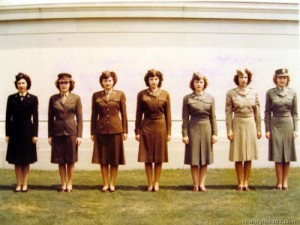 As early as the U.S. War for Independence women served on the battlefield as nurses, cooks, as well as other occupations. Although, they were not yet able to enlist in the armed forces at this time, women played major roles in the war effort. During the US-Mexican War (1846-48) a woman by the name of Elizabeth Newcom enlisted in the Missouri Volunteer Infantry under the name “Bill Newcom;” she was later discharged when it was revealed that she was in fact a woman. During the Spanish-American War (1898) women who were professionally qualified nurses were able to serve under contract to the U.S. Army. These women were assigned to Army hospitals in the USA, Puerto Rico, Hawaii, Cuba, Guam, the Philippines. Some were also assigned to the Hospital Ship Relief. The Army was so pleased by their performance that legislation subsequently passed establishing a permanent United States Army Nurse Corps (1901).
As early as the U.S. War for Independence women served on the battlefield as nurses, cooks, as well as other occupations. Although, they were not yet able to enlist in the armed forces at this time, women played major roles in the war effort. During the US-Mexican War (1846-48) a woman by the name of Elizabeth Newcom enlisted in the Missouri Volunteer Infantry under the name “Bill Newcom;” she was later discharged when it was revealed that she was in fact a woman. During the Spanish-American War (1898) women who were professionally qualified nurses were able to serve under contract to the U.S. Army. These women were assigned to Army hospitals in the USA, Puerto Rico, Hawaii, Cuba, Guam, the Philippines. Some were also assigned to the Hospital Ship Relief. The Army was so pleased by their performance that legislation subsequently passed establishing a permanent United States Army Nurse Corps (1901).
During the First World War, more than 1,476 U.S. female Navy nurses served in military hospitals in the United States and overseas. These women served without military rank but were later allowed to enlist in the Marines and Navy. Among these women, eighteen African-American military nurses served stateside taking care of African-American soldiers and German POWs. The Navy enlisted numerous women to serve in the United States to relive sailors of sea duty. Similarly, the Marines enlisted more than 305 women reservists who relieved “free men to fight” by serving as telephone operators and clerks in the United States. Unfortunately, like their male counterparts, many women died during World War I. More than 400 Army nurses died in the line of duty; most passed away from influenza, or “Spanish flu.” In the wake of World War II, Congressional legislation made women a permanent part of the United States armed services (1948).
Today, women are allowed to serve in any of the branch services (Army, Marine Corps, Navy, Airforce, or Coast Guard) as well as Reserves, although they remain unable to serve on the frontlines of combat. The Marine Corps has recently begun allowing women to compete and participate in the formerly all-male Infantry Officer School. No women have been able to complete the course. One woman who passed the enlisted portion contested that women are not meant for infantry because, “We are not built for it,” says Private Nisa Jovell. But in recent news, two women successfully completed the Army Ranger course, but have yet to join the 75th Ranger Regiment.
These are just a few examples of the many changes that have occurred in the way the U.S. Military utilizes women in the Armed Forces. It has taken many wars and battles for women to overcome challenges and to prove worthy of serving in the United States military. History is still in the making.
— Angela Marshall

 Saving...
Saving...